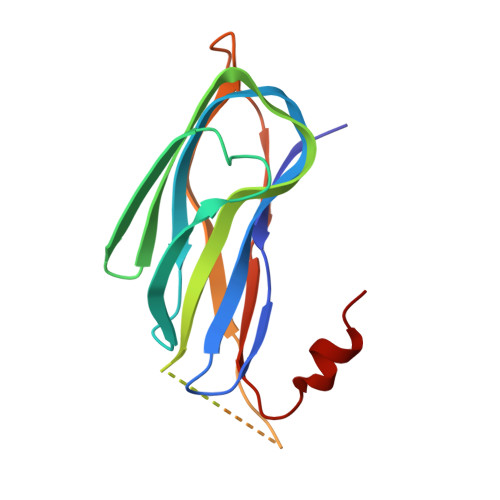Non-Cellulosomal Cohesin from the Hyperthermophilic Archaeon Archaeoglobus Fulgidus
Voronov-Goldman, M., Lamed, R., Noach, I., Borovok, I., Kwiat, M., Rosenheck, S., Shimon, L.J.W., Bayer, E.A., Frolow, F.(2011) Proteins 79: 50
- PubMed: 20954171
- DOI: https://doi.org/10.1002/prot.22857
- Primary Citation of Related Structures:
2XDH - PubMed Abstract:
The increasing numbers of published genomes has enabled extensive survey of protein sequences in nature. During the course of our studies on cellulolytic bacteria that produce multienzyme cellulosome complexes designed for efficient degradation of cellulosic substrates, we have investigated the intermodular cohesin-dockerin interaction, which provides the molecular basis for cellulosome assembly. An early search of the genome databases yielded the surprising existence of a dockerin-like sequence and two cohesin-like sequences in the hyperthermophilic noncellulolytic archaeon, Archaeoglobus fulgidus, which clearly contradicts the cellulosome paradigm. Here, we report a biochemical and biophysical analysis, which revealed particularly strong- and specific-binding interactions between these two cohesins and the single dockerin. The crystal structure of one of the recombinant cohesin modules was determined and found to resemble closely the type-I cohesin structure from the cellulosome of Clostridium thermocellum, with certain distinctive features: two of the loops in the archaeal cohesin structure are shorter than those of the C. thermocellum structure, and a large insertion of 27-amino acid residues, unique to the archaeal cohesin, appears to be largely disordered. Interestingly, the cohesin module undergoes reversible dimer and tetramer formation in solution, a property, which has not been observed previously for other cohesins. This is the first description of cohesin and dockerin interactions in a noncellulolytic archaeon and the first structure of an archaeal cohesin. This finding supports the notion that interactions based on the cohesin-dockerin paradigm are of more general occurrence and are not unique to the cellulosome system.
Organizational Affiliation:
Department of Molecular Microbiology and Biotechnology, George S. Wise Faculty of Life Sciences, Tel Aviv University, Ramat Aviv 69978, Israel.

















